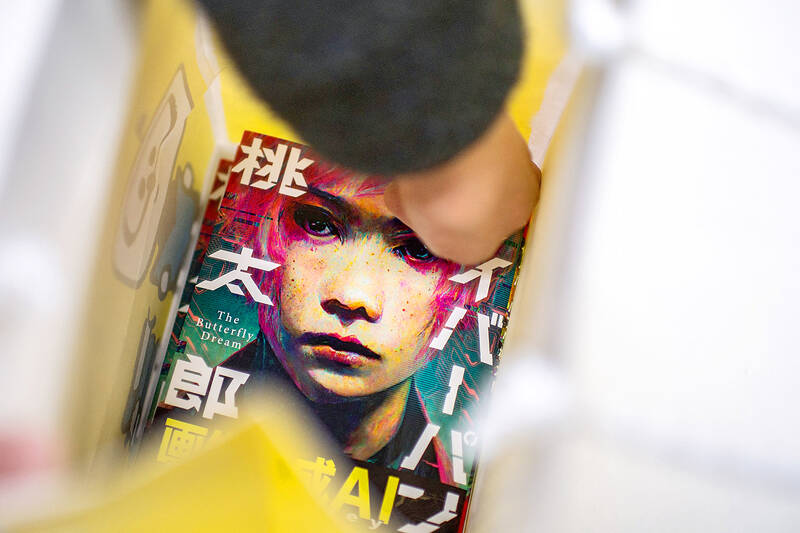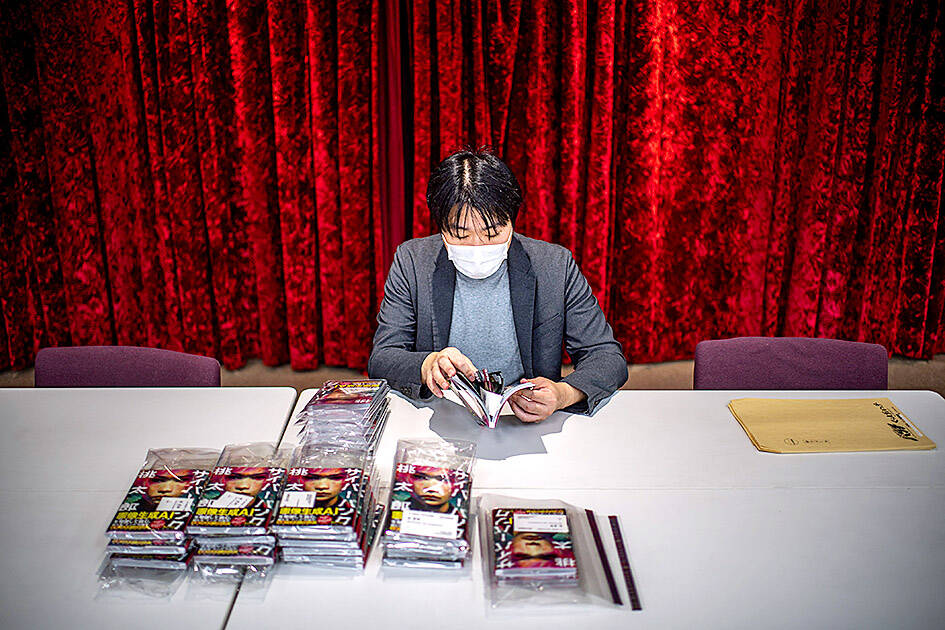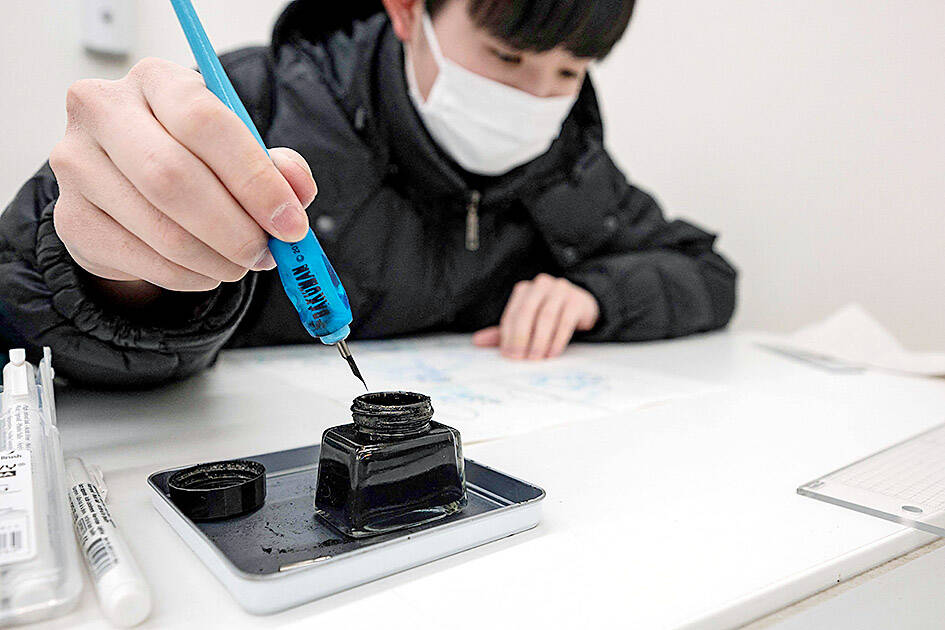The author of a sci-fi manga about to hit shelves in Japan admits he has “absolutely zero” drawing talent, so turned to artificial intelligence to create the dystopian saga.
All the futuristic contraptions and creatures in Cyberpunk: Peach John were intricately rendered by Midjourney, a viral AI tool that has sent the art world into a spin, along with others such as Stable Diffusion and DALL-E 2.
As Japan’s first fully AI-drawn manga, the work has raised questions over the threat technology could pose to jobs and copyright in the nation’s multi-billion-dollar comic book industry.

Photo: AFP
It took the author, who goes by the pen name Rootport, just six weeks to finish the over-100-page manga, which would have taken a skilled artist a year to complete, he said.
“It was a fun process, it reminded me of playing the lottery,” the 37-year-old said.
Rootport, a writer who has previously worked on manga plots, entered combinations of text prompts such as “pink hair,” “Asian boy” and “stadium jacket” to conjure up images of the story’s hero in around a minute.

Photo: AFP
He then laid out the best frames in comic-book format to produce the book, which has already sparked a buzz online ahead of its March 9 release by Shinchosha, a major publishing house.
Unlike traditional black-and-white manga, his brainchild is fully colored, although the faces of the same character sometimes appear in markedly different forms. Still, AI image generators have “paved the way for people without artistic talent to make inroads” into the manga industry — provided they have good stories to tell, the author said.
Rootport said he felt a sense of fulfillment when his text instructions, which he describes as magic “spells,” created an image that chimed with what he had imagined.

Photo: AFP
“But is it the same satisfaction you’d feel when you’ve drawn something by hand from scratch? Probably not.”
SOUL SEARCHING
Midjourney was developed in the US and soared to popularity worldwide after its launch last year.
Like other AI text-to-image generators, its fantastical, absurd and sometimes creepy inventions can be strikingly sophisticated, provoking soul-searching among artists.
The tools have also run into legal difficulties, with the London-based start-up behind Stable Diffusion facing lawsuits alleging the software scraped large amounts of copyrighted material from the web without permission.
Some Japanese lawmakers have raised concerns over artists’ rights, although experts say copyright infringements are unlikely if AI art is made using simple text prompts, with little human creativity.
Other people have warned that the technology could steal jobs from junior manga artists, who painstakingly paint background images for each scene.
When Netflix released a Japanese animated short in January using AI-generated backgrounds, it was lambasted online for not hiring human animators.
“The possibility that manga artists’ assistants will be replaced [by AI] isn’t zero,” Keio University professor Satoshi Kurihara said.
In 2020, Kurihara and his team published an AI-aided comic in the style of late manga pioneer Osamu Tezuka.
For that project, humans drew almost everything, but since then AI art has become “top notch” and is “bound to” influence the manga industry’s future, he said.
‘HUMANS STILL DOMINATE’
Some manga artists welcome the new possibilities offered by the technology.
“I don’t really see AI as a threat — rather, I think it can be a great companion,” said Madoka Kobayashi, whose career spans over 30 years.
Artificial intelligence can “help me visualize what I have in mind, and suggest rough ideas, which I then challenge myself to improve,” she said.
The author, who also trains aspiring manga artists at a Tokyo academy, argues that manga isn’t just built on aesthetics, but also on cleverly devised plots.
In that arena, “I’m confident humans still dominate.”
Even so, she recoils at copying directly from computer-generated images, because “I don’t know whose artwork they’re based on.”
At Tokyo Design Academy, Kobayashi uses figurines to help improve the students’ pencil drawings, including details ranging from muscles to creases in clothes and hair whorls.
“AI art is great... but I find human drawings more appealing, precisely because they are ‘messy,’” said 18-year-old student Ginjiro Uchida.
Computer programs don’t always capture the deliberately exaggerated hands or faces of a real manga artist, and “humans still have a better sense of humor,” he said.
Three major publishers declined to comment when asked whether they thought AI could disrupt Japan’s human-driven manga production process.
Rootport doubts fully AI-drawn manga will ever become mainstream, because real artists are better at making sure their illustrations fit the context.
But, “I also don’t think manga completely unaided by AI will remain dominant forever.”

June 2 to June 8 Taiwan’s woodcutters believe that if they see even one speck of red in their cooked rice, no matter how small, an accident is going to happen. Peng Chin-tian (彭錦田) swears that this has proven to be true at every stop during his decades-long career in the logging industry. Along with mining, timber harvesting was once considered the most dangerous profession in Taiwan. Not only were mishaps common during all stages of processing, it was difficult to transport the injured to get medical treatment. Many died during the arduous journey. Peng recounts some of his accidents in

“Why does Taiwan identity decline?”a group of researchers lead by University of Nevada political scientist Austin Wang (王宏恩) asked in a recent paper. After all, it is not difficult to explain the rise in Taiwanese identity after the early 1990s. But no model predicted its decline during the 2016-2018 period, they say. After testing various alternative explanations, Wang et al argue that the fall-off in Taiwanese identity during that period is related to voter hedging based on the performance of the Democratic Progressive Party (DPP). Since the DPP is perceived as the guardian of Taiwan identity, when it performs well,

The Taiwan People’s Party (TPP) on May 18 held a rally in Taichung to mark the anniversary of President William Lai’s (賴清德) inauguration on May 20. The title of the rally could be loosely translated to “May 18 recall fraudulent goods” (518退貨ㄌㄨㄚˋ!). Unlike in English, where the terms are the same, “recall” (退貨) in this context refers to product recalls due to damaged, defective or fraudulent merchandise, not the political recalls (罷免) currently dominating the headlines. I attended the rally to determine if the impression was correct that the TPP under party Chairman Huang Kuo-Chang (黃國昌) had little of a

At Computex 2025, Nvidia CEO Jensen Huang (黃仁勳) urged the government to subsidize AI. “All schools in Taiwan must integrate AI into their curricula,” he declared. A few months earlier, he said, “If I were a student today, I’d immediately start using tools like ChatGPT, Gemini Pro and Grok to learn, write and accelerate my thinking.” Huang sees the AI-bullet train leaving the station. And as one of its drivers, he’s worried about youth not getting on board — bad for their careers, and bad for his workforce. As a semiconductor supply-chain powerhouse and AI hub wannabe, Taiwan is seeing